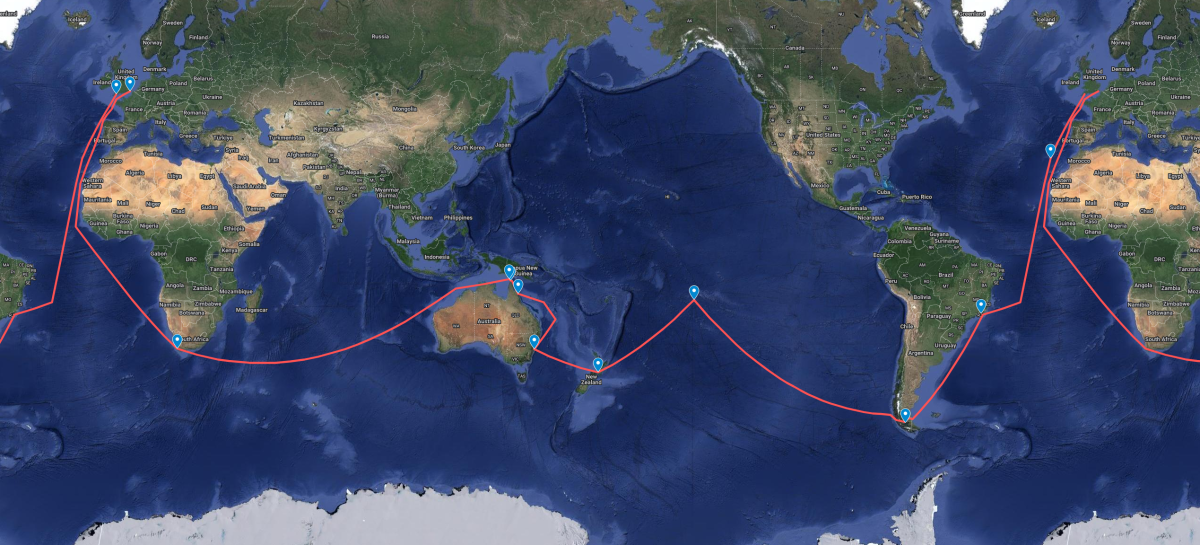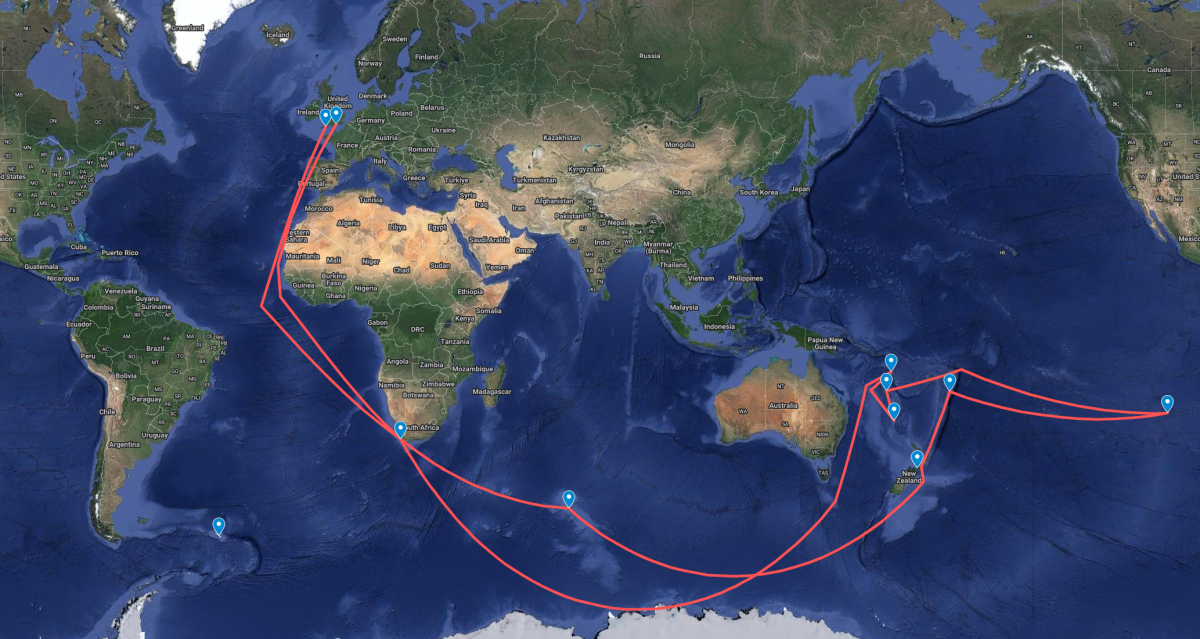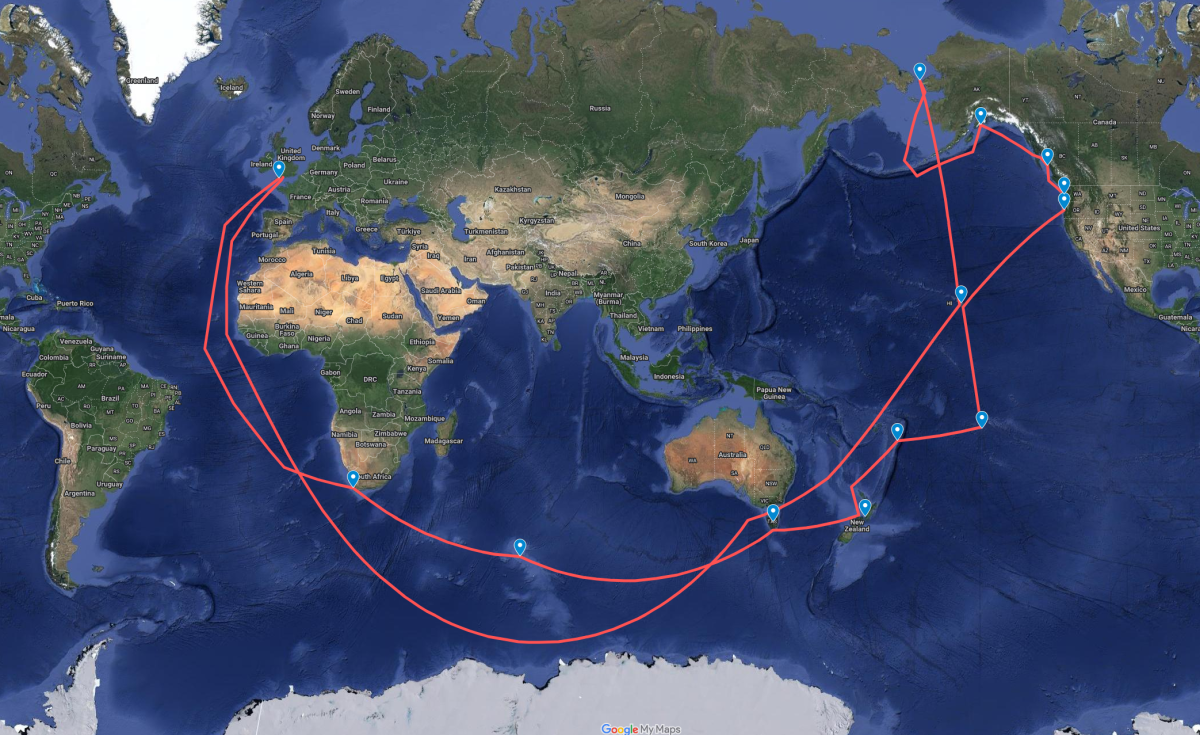Follow the routes of James Cook
Pacific Voyages
First Voyage (1768-1771)
Objective
To observe the transit of Venus across the sun from Tahiti and to search for the hypothesized southern continent, Terra Australis.
Ship
HMS Endeavour
Key Events
Tahiti: Cook successfully observed the transit of Venus in 1769.
New Zealand: He mapped the entire coastline, becoming the first European to do so, and confirmed that New Zealand was not part of a larger continent.
Eastern Australia: In 1770, Cook became the first European to make landfall on the east coast of Australia, at Botany Bay. He claimed the territory for Great Britain, naming it New South Wales.
Significance
This voyage disproved the existence of a large southern continent and provided extensive maps and scientific observations.
Key Places Visited
- Departure from England
- Date: August 26, 1768
- Port: Plymouth, England
- Ship: HMS Endeavour
- Madeira, Portugal
- Date: September 1768
- Purpose: Resupply and minor repairs.
- Rio de Janeiro, Brazil
- Date: November 1768
- Purpose: Further supplies and resupply; also to conduct observations and make astronomical measurements.
- Strait of Magellan
- Date: January 1769
- Significance: Navigated the treacherous strait to enter the Pacific Ocean.
- Tahiti, Society Islands
- Date: April – August 1769
- Purpose: To observe the transit of Venus across the sun on June 3, 1769.
- Significance: Successful observation provided valuable data for calculating the distance between the Earth and the Sun.
- New Zealand
- Date: October 1769 – March 1770
- Explorations:
- Mapped the entire coastline of New Zealand.
- Established that New Zealand was composed of two main islands (North and South Island) and was not part of a larger southern continent.
- Eastern Coast of Australia
- Date: April – August 1770
- Key Landfalls:
- Botany Bay: Landed in April 1770, named for the diverse plant specimens collected by botanists Joseph Banks and Daniel Solander.
- Endeavour River: Spent seven weeks repairing the ship after it ran aground on the Great Barrier Reef in June 1770.
- Possession Island: On August 22, 1770, Cook claimed the eastern coast of Australia for Great Britain, naming it New South Wales.
- Torres Strait
- Date: August 1770
- Significance: Successfully navigated the strait, demonstrating it was passable and thus separating New Guinea from Australia.
- Batavia (Jakarta), Dutch East Indies
- Date: October 1770 – December 1770
- Purpose: Repairs and resupply.
- Challenges: Many crew members fell ill due to the unsanitary conditions, leading to several deaths from diseases like malaria and dysentery.
- Cape Town, South Africa
- Date: March 1771
- Purpose: Further repairs and resupply.
- Return to England
- Date: July 12, 1771
- Port: Docked at Deal, Kent, England
- Significance: Completion of the voyage, bringing back extensive scientific data, maps, and specimens.
Discoveries
- Scientific Achievements: Cook’s first voyage was notable for its scientific achievements, including the successful observation of the transit of Venus, extensive botanical collections, and detailed mapping of previously uncharted territories.
- Geographical Discoveries: The mapping of New Zealand and the east coast of Australia provided the first accurate charts of these regions, greatly enhancing European knowledge.
- Interactions with Indigenous Peoples: Cook and his crew interacted with various indigenous populations, including the Māori in New Zealand and Aboriginal Australians. These interactions had significant and lasting impacts, both positive and negative.
- Claiming Territory: Cook’s claim of the eastern coast of Australia for Great Britain laid the groundwork for future British colonization.
Adventures
- Tahiti: Observation of the transit of Venus and the establishment of friendly relations with the Tahitians.
- New Zealand: Initial conflicts with the Māori, extensive coastal mapping, and cultural exchanges.
- Australia: Discovery and naming of Botany Bay, the dramatic grounding on the Great Barrier Reef, and the subsequent survival and repairs.
- Torres Strait: Successful navigation through a complex and hazardous region.
- Batavia: Enduring illness and loss of crew members.
Second Voyage (1772-1775)
Objective
To further explore the southern Pacific and search for Terra Australis.
Ships
HMS Resolution and HMS Adventure
Key Events
Antarctic Circle: Cook crossed the Antarctic Circle three times, becoming the first to do so, and provided evidence that the hypothesized southern continent did not exist.
South Pacific Islands: He made extensive explorations and mapping of islands, including Easter Island, Tonga, and the New Hebrides (Vanuatu).
Scientific Contributions: The expedition included botanists and naturalists, contributing valuable scientific data and collections.
Key Places Visited
- Departure from England
- Date: July 13, 1772
- Port: Plymouth, England
- Ships: HMS Resolution and HMS Adventure
- Cape Town, South Africa
- Date: October 1772
- Purpose: Resupply and prepare for the journey into the Southern Ocean.
- Crossing the Antarctic Circle
- Date: January 1773
- Significance: Cook became the first known explorer to cross the Antarctic Circle on January 17, 1773. He made three crossings during the voyage, disproving the existence of a large southern continent close to the equator.
- Kerguelen Islands
- Date: December 1772
- Discovery: These remote islands in the southern Indian Ocean were mapped and explored.
- Significance: Cook named the islands after their discoverer, Yves-Joseph de Kerguelen-Trémarec.
- New Zealand
- Visits: Several visits throughout the voyage (March 1773, October 1773, and February 1774).
- Explorations: Cook explored more of the New Zealand coastline and interacted with the Māori people.
- Tonga (Friendly Islands)
- Date: April 1773 and June 1774
- Explorations: Cook visited several islands in the Tongan archipelago.
- Significance: He named them the “Friendly Islands” due to the warm reception by the inhabitants.
- Easter Island
- Date: March 1774
- Explorations: Cook made detailed observations of the island and its famous statues (moai).
- Significance: His visit provided valuable information about the island and its people.
- New Caledonia
- Date: September 1774
- Discovery: Cook charted the eastern coast of this large island in the southwest Pacific.
- Significance: This was one of the last major landmasses in the Pacific to be discovered by Europeans.
- Norfolk Island
- Date: October 1774
- Discovery: Cook discovered and mapped this small island east of Australia.
- Significance: Norfolk Island was later used as a penal colony by the British.
- Vanuatu (New Hebrides)
- Date: July 1774
- Explorations: Cook explored several islands in the archipelago.
- Significance: These explorations added to the growing European knowledge of the Pacific islands.
- South Georgia and the South Sandwich Islands
- Date: January 1775
- Discovery: Cook discovered and mapped these islands in the southern Atlantic Ocean.
- Significance: He confirmed that these islands were not part of the hypothesized southern continent.
- Return to Cape Town
- Date: March 1775
- Purpose: Resupply and prepare for the return to England.
- Return to England
- Date: July 30, 1775
- Port: Portsmouth, England
- Significance: Completion of the voyage with significant geographical and scientific discoveries.
Geographical Discoveries
Crossing the Antarctic Circle
- First Crossing: Cook became the first known explorer to cross the Antarctic Circle on January 17, 1773.
- Significance: He crossed the Antarctic Circle three times, providing strong evidence against the existence of the hypothesized large southern continent, Terra Australis. Instead, he found that the southern regions were composed of vast icy seas and smaller landmasses.
Kerguelen Islands
- Discovery: Cook explored and mapped these remote islands in the southern Indian Ocean in December 1772.
- Significance: He named them after their discoverer, Yves-Joseph de Kerguelen-Trémarec, and provided detailed charts and descriptions of the islands.
South Georgia and the South Sandwich Islands
- Discovery: Cook discovered South Georgia in January 1775 and the South Sandwich Islands shortly thereafter.
- Significance: His detailed mapping of these islands in the southern Atlantic Ocean confirmed that they were not part of a larger southern continent, further debunking the Terra Australis hypothesis.
New Caledonia
- Discovery: Cook charted the eastern coast of this large island in the southwest Pacific in September 1774.
- Significance: New Caledonia was one of the last major landmasses in the Pacific to be discovered by Europeans, adding to the growing European knowledge of the region.
Norfolk Island
- Discovery: Cook discovered and mapped this small island east of Australia in October 1774.
- Significance: Norfolk Island was later used as a penal colony by the British, and its discovery was important for future colonization efforts.
Vanuatu (New Hebrides)
- Explorations: Cook explored several islands in the Vanuatu archipelago in July 1774.
- Significance: These explorations added to European knowledge of the Pacific islands and provided valuable information about the geography and cultures of the region.
Adventures
James Cook’s second voyage was marked by numerous adventures, from navigating through icy waters and discovering new lands to engaging with indigenous cultures and maintaining the health and morale of his crew in challenging conditions. These experiences highlighted Cook’s skill as an explorer, navigator, and leader.
Navigating the Southern Ocean: Cook and his crew faced the constant dangers of icebergs, sea ice, and harsh weather.
Discovering New Lands: The expedition charted and explored numerous previously unknown islands and coastlines.
Cultural Encounters: Interactions with indigenous peoples, including the Māori and Tongans, provided both challenges and opportunities for cultural exchange.
Scientific Exploration: The journey was marked by scientific observations and the collection of botanical and zoological specimens, adding to the adventure.
Third Voyage (1776-1779)
Objective
To discover the Northwest Passage, a potential trade route from the Pacific to the Atlantic through North America.
Ships
HMS Resolution and HMS Discovery
Key Events
Hawaii: Cook became the first European to visit the Hawaiian Islands in 1778, naming them the Sandwich Islands.
North American Coast: He explored the west coast of North America, from California to the Bering Strait, searching for the Northwest Passage.
Return to Hawaii: Cook returned to Hawaii in 1779, where conflicts with the local population led to his death.
Key Places Visited
- Departure from England
- Date: July 12, 1776
- Port: Plymouth, England
- Ships: HMS Resolution and HMS Discovery
- Cape Town, South Africa
- Date: October 1776
- Purpose: Resupply and prepare for the journey into the Pacific.
- Kerguelen Islands
- Date: December 1776
- Revisit: Cook revisited these remote islands for further exploration and mapping.
- Tasmania (Van Diemen’s Land)
- Date: January 1777
- Exploration: Cook explored the coastlines and interacted with indigenous peoples.
- New Zealand
- Visits: February 1777
- Explorations: Additional mapping and interactions with the Māori people.
- Tonga (Friendly Islands)
- Date: April 1777
- Explorations: Further visits to the Tongan archipelago, strengthening relations and acquiring provisions.
- Tahiti
- Date: August 1777
- Interaction: Renewed contact with the Tahitian people and preparations for the journey northward.
- Hawaii (Sandwich Islands)
- Discovery: January 1778
- Significance: Cook was the first European to visit the Hawaiian Islands, naming them the Sandwich Islands in honour of the Earl of Sandwich.
- Explorations: Detailed mapping and interactions with the native Hawaiian people.
- Northwestern Coast of North America
- Date: March 1778
- Explorations: Cook explored and mapped the coastlines of what are now Oregon, Washington, British Columbia, and Alaska.
- Significance: Searched for the Northwest Passage along these coasts.
- Bering Strait and Arctic Ocean
- Date: August 1778
- Explorations: Attempted to navigate through the Bering Strait into the Arctic Ocean.
- Challenges: Encountered impassable ice, forcing Cook to turn back.
- Return to Hawaii
- Date: Late 1778
- Explorations: Cook returned to Hawaii to spend the winter, interacting extensively with the Hawaiian people.
- Death of James Cook
- Location: Kealakekua Bay, Hawaii
- Date: February 14, 1779
- Event: Cook was killed in a conflict with Hawaiians during his second visit to the islands.
- Return Journey
- Completion: After Cook’s death, the expedition continued under the command of Charles Clerke and later John Gore.
- Final Destinations: The expedition continued to explore the Pacific and Arctic regions before returning to England in October 1780
Discoveries
Hawaiian Islands (Sandwich Islands)
- Discovery: Cook was the first European to visit the Hawaiian Islands in January 1778.
- Significance: He named them the Sandwich Islands in honour of John Montagu, the 4th Earl of Sandwich. The discovery led to detailed mapping and interactions with the native Hawaiian people, marking the beginning of European interest in Hawaii.
Northwestern Coast of North America
- Explorations: Cook explored and mapped the coastlines of what are now Oregon, Washington, British Columbia, and Alaska.
- Significance: These explorations provided detailed charts and increased European understanding of the Pacific Northwest’s geography.
Bering Strait and Arctic Ocean
- Attempted Passage: Cook attempted to navigate through the Bering Strait into the Arctic Ocean in August 1778.
- Challenges: Encountered impassable ice, which forced him to turn back.
- Significance: Although he did not find the Northwest Passage, his detailed observations and maps of the region added valuable information about the Arctic.
Death
James Cook was killed on February 14, 1779, during a skirmish with Hawaiians at Kealakekua Bay.
Legacy
Cartography: Cook’s detailed maps and charts were among the most accurate of the time and were used for many years.
Scientific Contributions: His voyages included numerous scientific discoveries and extensive collections of flora and fauna, contributing significantly to the fields of astronomy, biology, and geography.
Exploration: Cook’s expeditions expanded European knowledge of the Pacific region, Australia, New Zealand, and the west coast of North America.
Impact on Indigenous Peoples: Cook’s interactions with indigenous populations had complex and lasting impacts, ranging from the introduction of new goods and ideas to the spread of diseases and eventual colonialism.
Interesting Facts
Navigation and Leadership: Cook was known for his exceptional skills in navigation, cartography, and leadership, maintaining relatively healthy crews through measures such as the use of fresh food and hygiene practices to prevent scurvy.
Recognition: Cook was honoured and respected during his lifetime, receiving several promotions and accolades for his contributions to exploration and science.
James Cook’s meticulous approach to mapping and scientific inquiry set new standards for future explorers, with his voyages marking a significant era of exploration, contributing greatly to the knowledge and understanding of the world’s oceans and lands.




